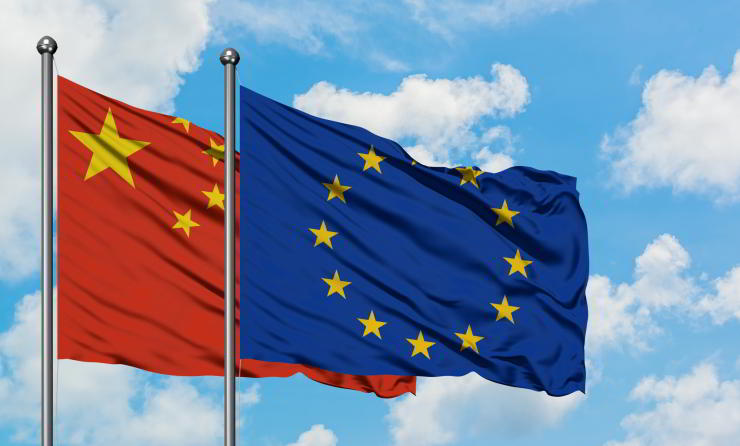The Trump Effect: Reconciling China and the European Union.

The strong tensions triggered by the protectionist trade policies introduced by the new US administration open up significant opportunities for the People’s Republic of China, both in Europe and in the Indo-Pacific.
The need to structure solid supply chains, especially in a phase of strong political and economic uncertainty such as that of the present day, could in fact force a rapprochement between China and the European Union (EU), as well as favour the deepening of regional cooperation between traditionally rival Asian players.
In February, amid the American economic and trade offensive, the President of the European Commission, Ursula von der Leyen, already spoke of the possibility of negotiating new agreements with China, aimed at expanding trade and investment ties. In parallel, the European Parliament has lifted the restrictions that have prevented MEPs from meeting Chinese officials since 2021 and has simplified the procedure for missions to China.
These moves, coming after years of European policies aimed at implementing the strategy of economic de-risking from the People’s Republic, mark a revolution (although at the moment only rhetorical) in the EU’s position towards its Chinese partner. With the pandemic first and then the Russian invasion of Ukraine, the Union had tried to progressively loosen economic ties with Beijing, limiting, among other things, the flow of direct investments in strategic sectors.
In this context, the recent opening of the EU, even if probably only tactical and aimed at sending a signal to the Trump administration, represents a relevant turning point. Even the EU’s plan to respond to the trade attack was expected for April 2, but was postponed for another 90 days; however, to be truly effective, will have to include Asian partners such as China in the medium to long term.
For its part, Beijing has welcomed the messages of openness from Brussels and has increased diplomatic pressure aimed at exploiting the emergence of apparently favourable environmental conditions. The contradictions and political and economic fractures that have emerged between the US and the EU leave ample room for manoeuvre for China, a completely unexpected dynamic just a few months ago, when Brussels announced duties against electric vehicles produced in the People’s Republic and several Chinese companies were included in the sanctions packages against Russia.
Since the beginning of 2025, therefore, Chinese diplomacy has wasted no time and has promptly sided with the Europeans, both on the Ukrainian dossier, where China is asking for the EU’s involvement in the negotiations, and on the issue of contrasting American trade policies. In a broader sense, China aims to form a common front with the EU against perceived US unilateralism, animating the front of countries that feel politically betrayed and that risk suffering the greatest repercussions from the aggressive trade policies imposed by Washington.
This posture, in addition to confirming the desire to show closeness to European partners and recover ground on the Central-Eastern front, where the actors most affected by the Russian-Ukrainian war reside, also appears to be linked to the country’s general interests,
not least those in the Indo-Pacific.
In this sense, admitting the EU’s exclusion from negotiations on the future European security architecture clashes with the Chinese principle of opposition to the interference of third-party actors in regional political quadrants. At the same time, China does not perceive positively, also for historical reasons, the exclusion from political negotiations of actors directly involved in the disputes.
Finally, an excessive strengthening of the Russian post-conflict position creates some concerns for Beijing, especially in light of the relationship consolidated by Moscow with relevant Asian actors, such as Myanmar and North Korea.
But the efforts of Chinese diplomacy, at this stage, go well beyond the European context and are concentrated above all in Asia, in the country’s wider neighbourhood. In recent months, in fact, while waiting to understand the scope of the measures announced by the new US administration, the People’s Republic gradually proceeded to thaw relations with India, also in order to avoid tensions along the border at a time when neither actor appears interested in the clash.
In parallel, the trip to Tokyo by the Chinese Foreign Minister, Wang Yi, on the occasion of the 11th meeting with his counterparts from Japan and South Korea, paved the way for the first trilateral economic dialogue between the countries in five years that was held at the end of March in Seoul. On this occasion, the Trade Ministers of the three Asian countries agreed on the desire to cooperate at the highest levels in view of potential agreements aimed at facilitating regional trade.
In addition to the implementation of the Regional Comprehensive Economic Partnership (RCEP), of which the three countries are an integral part, the exchange concerned the revitalisation of the dialogues on the Free Trade Agreement (FTA).
The news comes following the repeated and so far, failed attempts by Japan and South Korea to obtain ad hoc exemptions from the sanctions regimes introduced by the Trump administration. As recently as March 27, Japanese Prime Minister Shigeru Ishiba had declared that the 25% duties on cars and components exported to the United States would have triggered a strong reaction and that all options were on the table.
Even the South Korean leadership itself, aware of the country’s strong vulnerability to protectionist policies, asked the United States in March for specific exemptions, which have so far never been obtained. China, therefore, has so far shown a fair amount of skill in exploiting tensions and contradictions triggered by controversial American policies, and in perspective, its position could further strengthen, especially if the cracks in the Euro-Atlantic bloc consolidate and the distance between Washington and its partners in the Indo-Pacific widens.
However, a potential economic rapprochement in the short term will have to deal with the lack of political alignment in the medium and long term. From this perspective, therefore, only an irreparable rift between Washington and its partners could favour the Chinese strategy. (Photo: China and European Union flag. 123rf)
Tiziano Marino/CeSI



